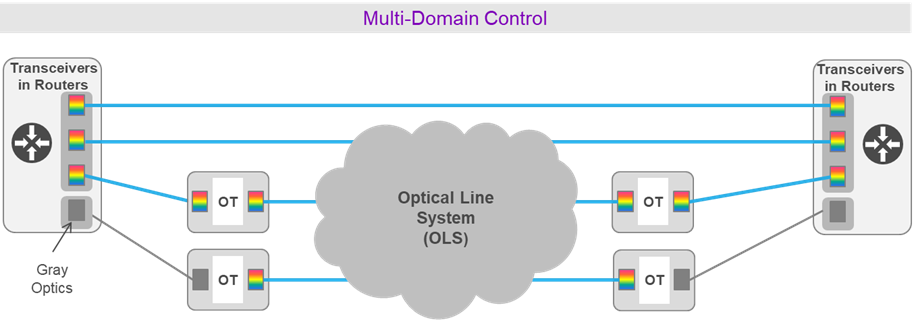Unifying Coherent Routing with Optical Transport
Along with my colleague Jonathan Homa and Jimmy Yu of the Dell’Oro Group, I recently participated in a webinar in which we discussed the roles played by Coherent Routing and Optical Transport in supporting the rapidly increasing demands placed on the IP Optical middle mile network.
One of the topics we explored was how advances in Optical technology and small form factor pluggables have enabled Coherent Routing, and why Coherent Routing allows IP Routing and Optical Transport to form a symbiotic relationship.
You can listen to the full webinar here. Some highlights from our conversation:
Key Elements of the IP Optical Middle Mile Network
The "middle mile" connects the last mile access networks with core services and applications, and needs to be service-aware, agile enough to support service evolution and optimized to minimize TCO. It is composed of the following main elements:
- IP Aggregation Routers provide the service aware aggregation and transport of traffic from multiple access networks.
- Open Optical Line Systems (OLS) provide lowest cost per bit transport; traditionally coherent transceivers sit with the optical networking equipment.
- Coherent Transceivers: new advances in small form factor coherent transceivers allow them either to sit in the routers or to remain in optical transport devices. This gives network architects the flexibility to locate the transceivers wherever best fits their needs.
- Domain Control: traditionally element/network managers providing little to no integration between the optical networking and IP aggregation layers. Modern domain control systems provide multilayer lifecycle management across both the IP aggregation and optical networking components of the middle mile.
Two Approaches to Coherent Transceiver Optimization
Capacity-Reach Optimized: The High-Capacity Approach
This approach is used to deliver maximum performance. These transceivers push the boundaries of wavelength capacity and reach, currently supporting up to 1.2T wavelengths for short-haul applications. For long-haul
Power-Cost Optimized: The Metro Approach
This approach focuses on power efficiency and cost-effectiveness, catering to extended metro applications. These transceivers adhere to standard form factors like QSFP-DD and QSFP28. Routers and switches in coherent routing applications exclusively use these compact, power-optimized pluggables, while optical transport systems leverage both types of transceivers.
Configuring Network Applications
Various configurations utilize these transceivers differently:
- Simple Point-to-Point (P2P) Applications: routers communicate directly without coherent optics.
- Coherent Routing Solutions: similar to the simple point-to-point applications but using coherent receivers, or when required, more Optical Line Systems (OLS) are used to support longer reaches or to provide wavelength routing with ROADMs.
- Traditional Optical Transport Architectures: here, the routers use either coherent transceivers or cost-effective gray optics, depending on network size and complexity.

Key Considerations for Coherent Routing
- Vendor Neutral Open OLS: an OLS is essential for many coherent routing applications. This OLS must be vendor neutral -- it must handle any wavelength from any source and utilize a flexible grid to meet spectral needs. Other requirements include add-and-drop capabilities, amplification, restorability, monitoring, spectral band management, and value-added functionalities like shared spectrum.
- Domain Control: a multi-layer domain controller seamlessly integrates control of both IP aggregation and optical components, providing full lifecycle management of the middle mile network
Use Cases: Coherent Transceivers in Action
Specific uses case where coherent routing can be extended by the addition of an optical transport.
- Router Flexibility and Traffic Aggregation: optical transport layers aggregate 100G interfaces from routers, consolidating traffic onto a single 400GZR+ wavelength. This approach optimizes traffic flow and reduces the number of wavelengths required.
- 400G Regeneration: ZR+ transceivers offer high power and longer reach for extended metro applications. When longer reach is needed, optical transport layers can regenerate signals, avoiding the cost and delay of additional routers.
- The High-Capacity Approach for Short and Long Haul Applications: higher-powered transceivers support up to 1.2T wavelengths today, with future capacities set to increase. These are ideal for high-density short haul applications, with demonstrated reach of up to 1,500km at 800G. An example includes a 1,650km connection achieved with SURF, transporting two 400GbE services over a single 800G link. These are also ideal for regional and long haul applications, with virtually unlimited reach at 400G.
Conclusion
Rather than viewing network architecture as a choice between coherent routing and optical transport, the future lies in integrating both. This synergy maximizes performance, efficiency, and flexibility, paving the way for robust, scalable networks. Ribbon Intelligent Middle Mile is leading the charge in using an integrated approach to coherent routing and optical transport, allowing services to be transported with differentiated performance at the lowest TCO.
Whitepaper: Building the Intelligent Middle Mile


